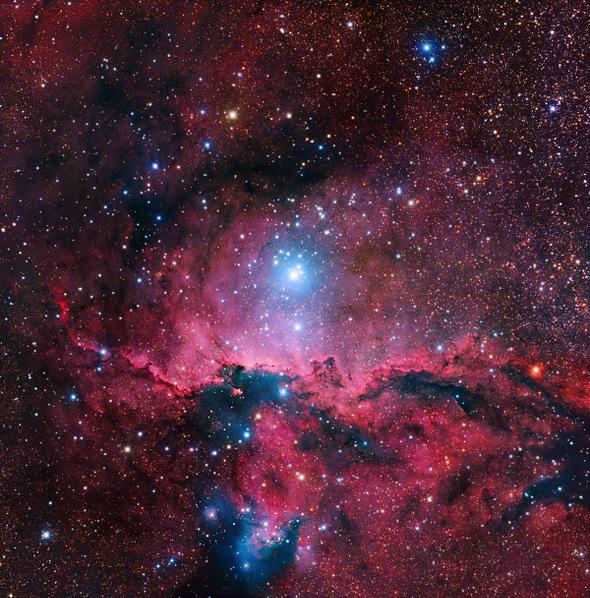Today I’m going to toss a little bit of math your way. If you’re an arithmophobe, never fear: It’s mostly just me throwing around some gee-whiz numbers, and I’ll help you swallow this medicine with the sweet, sweet eye candy above.
That image is from Robert Gendler, Roberto Colombari, and Martin Pugh, and it shows the young star cluster called NGC 6193 embedded in a vast cloud of gas and dust called NGC 6188. Both are very roughly 4,000 light-years away in the constellation of Ara. The image combines data from the huge 8.2 meter Very Large Telescope in Chile with some from a much smaller 32 cm telescope.
The cluster is young, only a few million years old. The brightest stars in it are massive, hot, luminous, and blue. They flood out light, illuminating and ionizing the gas in the cloud, which responds by glowing red.
I could go into details, but I already have in countless posts about emission nebulae, as well as in Crash Course: Nebulae. I’ll leave it up to you, Bad Readers, to determine how deeply you want to dive into those particulars by clicking those links.
But I want to point something out. Images like this are gorgeous, and always stop me in my tracks. The details, the colors, the structure of the gas … all of these combine to make such arresting images!
Still, it’s the science behind them that touches some atavistic part of my brain, giving me a chill that is both intellectual and visceral.

ESO/Gendler, Colombari, and Pugh
In many such nebulae, there are quite a few massive stars lighting them up, sometimes dozens of them. But in others, like NGC 6188, it’s only a few. In this case I mean that literally: The vast majority of energy pumped into the gas is being done by three stars.
In the center of the nebula you can see two stars, their cores blurred into a single smear, but their distinct presence revealed by the pair of X-shaped diffraction spikes coming out from them. Moreover, one of those two is itself a binary star, two stars in close orbit, so close they appear as one. So you’re actually seeing three stars there! One is a brutal O3 star, probably 50,000 times more energetic than the Sun, and the other two are O6, smaller but still beasts. All together they probably crank out 100,000 times as much light as the Sun does.
If you replaced the Sun with any of those three stars, the Earth wouldn’t last long. It’d be fried to a crisp.
But here’s the thing: The glowing part of that nebula, the gas energized by those stars, is roughly 20 light-years across. That’s 200 trillion kilometers! All that gas, probably several times the mass of the Sun, glowing due to the light of just three stars.
That made me wonder: How many photons are those stars emitting?
The math on that isn’t so bad. I won’t start from first physics principles, because that would take a lot of words. Instead, let me skip around a bit.
First, how many photons does the Sun emit? Well, the energy of a photon is defined by its wavelength or frequency. The Sun emits most strongly in the green portion of the spectrum, and that’s a wavelength of about 0.5 microns (or 500 nanometers if you prefer). The equation of the energy in a single photon is:
Energy = h x c / wavelength
Where h is Planck’s constant (just a number that has units of energy times time), and c is the speed of light. You can look those numbers up, but in the end the answer is that a single green photon has an energy of about 4 x 10-19 Joules (a Joule is a unit of energy; the energy stored in a single calorie of food is equivalent to more than 4,000 Joules).
The Sun emits about 4 x 1026 Joules of energy every second. That’s spread out over many different colors, each with their own energy, but I’m being really rough here, so assume they’re all green for math purposes. Dividing that total energy by the energy per photon gives us the number of photons the Sun emits:
4 x 1026 / 4 x 10-19 = 1045
Holy. WOW. That’s a lot of photons. Written out it’s:
1,000,000,000,000,000,000,000,000,000,000,000,000,000,000,000 photons!
And that’s every second. The Sun has been doing this for 4.6 billion years, so I’ll leave it to you to figure out how many photons total the Sun’s given off since it was born (but it’s roughly 1062, and yikes).
Mind you, those stars lighting up NGC 6188 are 100,000 times brighter than the Sun, so they emit 1050 photons per second! They also tend to emit higher energy light, like ultraviolet. That kind of light is preferentially absorbed by the hydrogen in the gas cloud. That ionizes the gas, blasting the electrons off the atoms. When the electron recombines, it re-emits that energy as light, usually that characteristic red you see in the image.
That’s how (well, in part that’s how) just a few stars can light up gas for trillions of kilometers around.
Funny, too: As bright as those stars are, distance is more important. At 4,000 light-years away, they’re 250 million times farther away from the Sun*. So even though they blast out 100,000 as much energy, they’re just barely visible to the naked eye at that distance. I’m not sure what’s more unnerving: The energies involved, or the vast distances. Both are mind-numbing.
So in case you were wondering, when I see astronomical images, that’s the sort of stuff that goes through my mind. I’ve said it many times, but it bears repeating: There is great beauty in astronomy, but that’s dwarfed by what these cosmic artworks teach us about the Universe.
* Correction (Oct. 26, 2016): I originally wrote 250 billion here. Oops. Still, they’re a long ways off.
